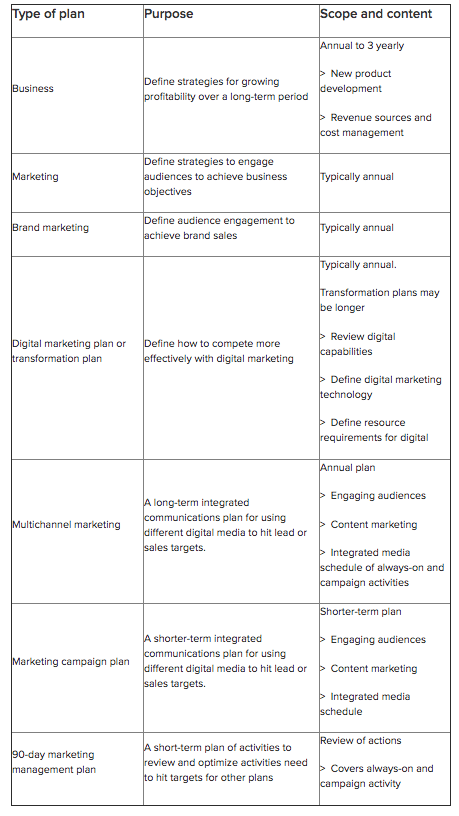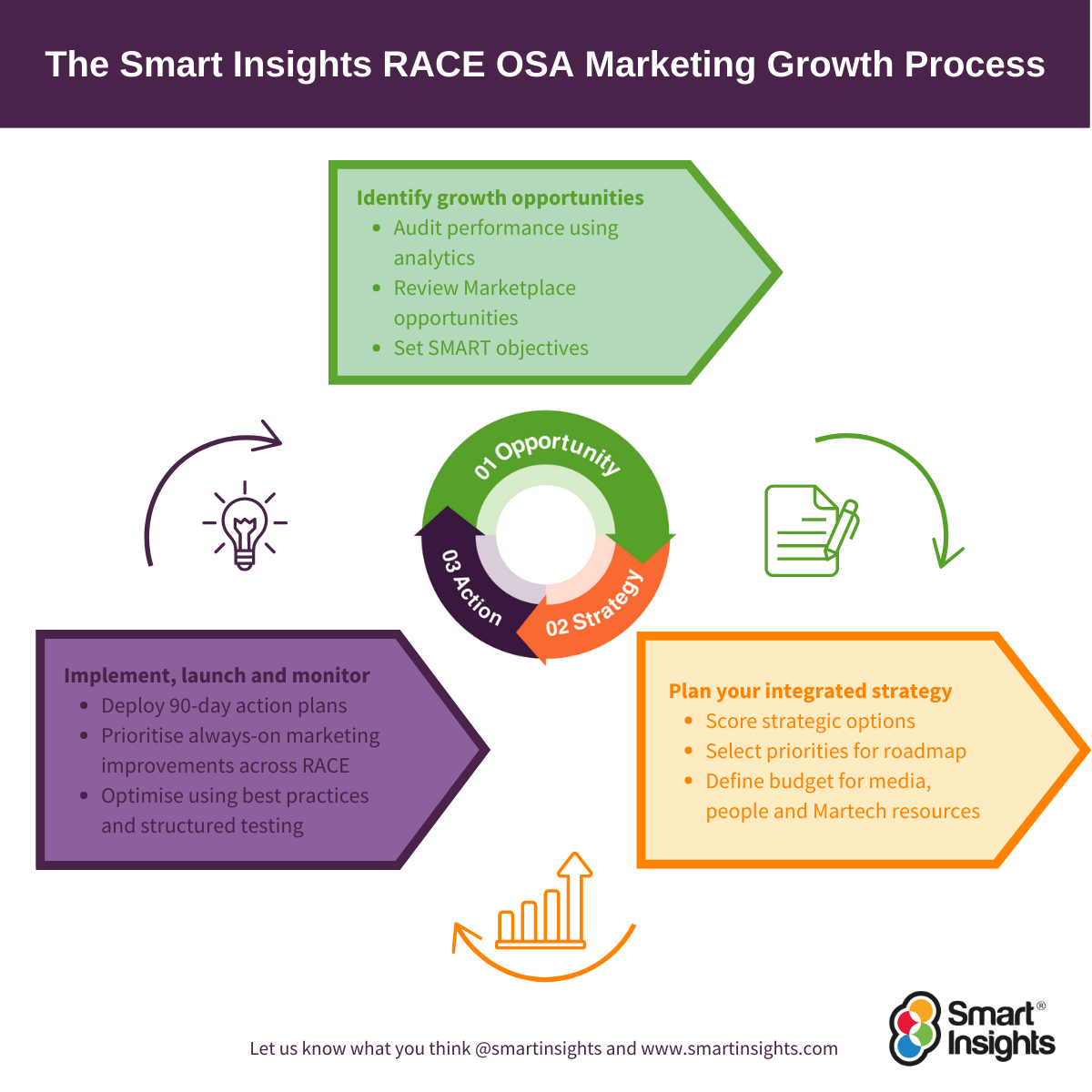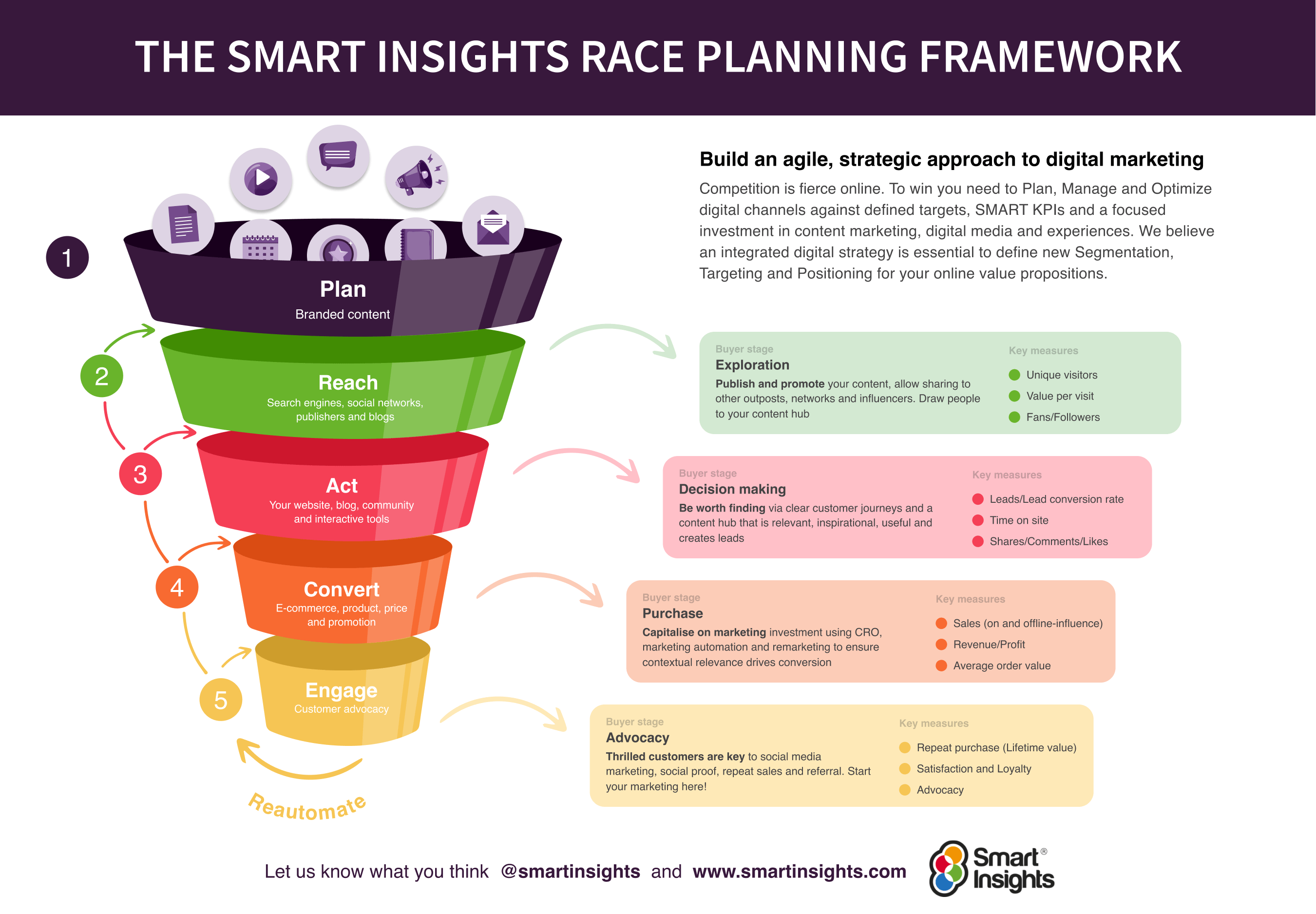Using the RACE OSA process to structure a marketing plan
A marketing plan is an essential tool to compete and grow your business since it gives focus to your marketing activities by setting realistic, achievable priorities within your budget.
It simply defines what you want to gain from your investment in marketing and how you will achieve these goals through selecting the best marketing strategies and channels to acquire and retain customers.
A typical definition of a marketing plan used by traditional marketers is:
"A marketing plan is a strategic document that specifies your organization’s target markets, marketing objectives, programs, and activities to achieve them, expected timescales, resources to be utilized, according to defined budgets, and how success will be measured".
This is logical and simple and that's what we need to achieve through the structure of an effective marketing plan. However, for today's marketing where digital marketing channels are so important we need a marketing plan and template structure that are fit for purpose. That's why we developed the RACE Growth System since it details the communications activities that need to be used for success.
In this post, I will explain RACE OSA, a practical three-part marketing plan structure particularly suitable for small and medium businesses to rapidly develop comprehensive marketing plans. OSA stands for:
Opportunity > Structure > Action.
For each of these 3 parts, I will summarize what you need to include and why. There are 5 steps in each part giving 15 sections in all. This is simple enough to make it quick and easy, but detailed enough to work in the real world.
You can download our Free marketing plan template based on this 15-step OSA structure!
Free marketing plan template
Our popular marketing planning template is structured across the Smart Insights RACE OSA Framework. Join Smart Insights as a Free Member to download our marketing plan template today
Access the Free marketing plan template
Many marketing plan templates were created long ago for larger businesses and aren’t so relevant to small and startup businesses competing in today’s marketplace where effective digital marketing is essential. Long plans with sections labelled ‘mission and vision statement’ and ‘corporate strategies’ are irrelevant for smaller businesses.
Our recommended format is far more practical since it relates to the real-world challenges and opportunities of a smaller business. The template shares the key features of our RACE Growth system since it is designed to be:
- Quick to create and implement an actionable plan with simple steps
- Data-driven, defining SMART objectives based on forecasts
- Practical to implement using a 90-day planning approach to give you focus
- Designed for smaller businesses, but relevant for larger businesses too
But first, we need to remind ourselves of the goals for our marketing plan and how it fits within the business as a whole. We will also introduce the Smart Insights RACE Growth System.
What is the purpose of a marketing plan?
The purpose of a marketing plan is to define strategies to engage audiences in order to achieve business objectives.
The goal of a marketing plan is to ensure marketing activities are structured, relevant, and timely to achieve an organization’s objectives.
It’s a plan defining your company's sustainable competitive position, structuring and setting marketing goals, and defining the resources necessary to achieve your business vision.
A marketing plan should include:
- The current performance, priorities, and direction of your organization
- Its marketplace position in relation to external environmental factors including competitors and PESTLE macro-factors
- A critical analysis of your organization’s strengths, weaknesses, opportunities, and threats. We recommend using the powerful TOWs marketing plan analysis summary.
- Clearly defined SMART marketing objectives and a way to benchmark their success
- The means by which to achieve those objectives through strategies for STP: Segmentation, Targeting and Brand Positioning
- Relevant and timely actions and responsibilities by function, product or service, and market segment
- Investment in communications activities to reach your audience and convince them to convert including, all important always-on marketing activities.
- Investment in sales and customer service activities to encourage them to buy for the first time and repeat purchases.
- The finances and resources required and forecasted revenues
- Regular measurement of progress and outcomes against benchmarks
So, to summarize, a solid marketing plan outline has:
- Clear, realistic goals that you can be confident of hitting
- The best strategy to achieve these goals against your competition
- Sufficient details of the tactics and actions needed to translate the strategy into action
- A method to check you are on track with your plans
The business context of a marketing plan
Where does the marketing plan fit within the business? Here’s another way of understanding the context of a marketing plan, to put it into context with other types of plans, as shown in this table:

When to use a marketing plan?
The process of marketing planning within an organization will differ, depending on whether a strategic marketing plan or an operational marketing plan is utilized. Here are the differences between the two:
- A strategic marketing plan outlines the overall strategy within a market, connecting customers, competitors, and what the organization is capable of achieving. It is typically created at divisional or company level.
- An operational marketing plan outlines the marketing mix strategy that will be used to gain an advantage in the market. It typically focuses on products; market segments and how marketing communications and campaigns achieve targets defined in the strategic marketing plan. It usually has separate sections covering tactics for customer acquisition and retention which will sometimes be covered in separate plans in larger organizations.
In an organization’s planning process, marketing links:
- Customers’ needs and wants
- Competitor value proposition and actions
- Strategic direction
- Organizational objectives
What should your plan include? Our recommended marketing plan structure
Before we get into the details, let's look at the big picture which defines the process you will follow to develop and implement your marketing plan.
3-step marketing plan outline
Within the RACE system, we call this process OSA to keep it simple - marketing plans don't have to be complex. OSA stands for Opportunity, Strategy, Action. The visual outline shows some of the activities that are needed to plan for success under each stage of OSA.

Within OSA for a marketing plan format, these are the sections we recommend that are included in our template with more details on each.
Opportunity
- Audit performance
- Review marketplace
- Key issues summary
- Set objectives
Strategy:
- Review marketing and digital strategy options
- Assess budget / business case
- Prioritize and select strategic initiatives
Action:
- Plan 90-day activities
- Implement plans
- Review results
Use our free planning templates to get started with using RACE to grow your business. These will help you create a 90-day prioritized plan to improve your results from digital marketing. We recommend 25+ key marketing activities across RACE that are essential for businesses to compete by improving their digital marketing maturity.

Free marketing plan template
Our popular marketing planning template is structured across the Smart Insights RACE OSA Framework. Join Smart Insights as a Free Member to download our marketing plan template today
Access the Free marketing plan template
Which types of businesses use marketing plans?
Marketing planning will assist in the day-to-day running of any size, type or age of business. The targets and milestones set will help organizations, from small start-ups to large corporates, to effectively:
- Allocate resources and budget
- Motivate teams
- Manage the performance of staff members and marketing efforts
Marketing plans for small businesses
In smaller businesses, the scope of a plan is typically annual and for the whole business. Typically, SMEs are working with smaller budgets and tighter turnaround times.
A marketing plan for a small business typically looks to identify where to prioritize the investment of time and available budget to generate results.
Smaller organizations typically have:
- Small market shares
- Owners involved in all aspects of strategic and operational management
- Independence
- A high degree of uncertainty
- Difficulty innovating owing to limited resources
Such differences between large and smaller organizations tend to be reflected in the development of marketing plans.
When establishing a small start-up, marketing planning is an essential element. A small number of these businesses launch and grow, but for those that are successful, a strategic marketing approach will ensure continued development.
Marketing plans for large organizations
In large organizations, its focus will change, depending on the type of organization. A separate marketing plan might be:
- Geographically-based
- Product-based
- Business unit based
- Focused on segmentation
A marketing plan in a large organization may integrate a number of plans, specific to individual parts of the business. It is practical planning that takes place at a divisional, business unit, or individual company level.
Larger organizations with clearly defined management structures and a wealth of resources will make use of marketing principles very differently from smaller organizations.
Structure an effective marketing plan with RACE
Did you know - nearly half of companies don't have a clearly defined digital marketing strategy? These companies are missing opportunities for better integration and risk losing customers due to out-of-date processes.
Savvy marketers and Smart Insights members already recognize that a practical, integrated marketing plan is essential for business growth in 2024 and beyond.
If you're looking for a quick marketing plan structure to hone your performance and strategize your approach to marketing, why not download our free marketing plan template?
How to format your marketing funnel
Although the techniques for marketing planning may vary between different sizes and types of organizations, the outcome is always the same: to implement the objectives, strategies, and activities in order to gain an advantage.
That's why our RACE Framework is structured across a simple 5-step marketing and sales funnel which can be applied to every size of business from startups to multinational corporations:
- Plan
- Reach
- Act
- Convert
- Engage

How does a marketing plan relate to other plans?
The plan should not be formulated or used in isolation; it should be informed by the corporate objectives identified in your organization’s business plan.
Integrated with a marketing plan may also be a digital plan, multi-channel plan and campaign plan, for example. The marketing plan informs these plans and vice-versa.
An effective marketing plan will ensure the integration of activities, the scheduling of requirements, distinguishing responsibilities and the provision of benchmarks for measuring success.
Different organizations will utilize differing plans, covering different areas and timeframes. What is crucial in a business is that the plans being utilized, the timeframes allocated, and how they integrate with each other are collectively established.
Structure your marketing plan around a funnel proven to boost performance. Join Smart Insights as a Free Member for instant access to our Free marketing plan template to hone your skills and drive the results you need.
Thanks to Sarah Cowman for sharing their advice and opinion in this post. Sarah, Managing Director at The Yorkshire Marketing Agency, is an award-winning Chartered Marketer. Sarah holds over 10 years’ experience in implementing results-driven marketing and communications strategies, plans and campaigns. You can connect with her on
LinkedIn.





















